F. Mannlicher experimental semi-automatic rifle M1905 (Austria-Hungary)
In his latest project, F. Mannlicher decided to use some existing ideas, and also to introduce a number of new solutions. The main idea of the M1905 project was to adapt the existing automation system to a new cartridge. Back in 1901, the designer created a new pistol with automatics based on a free gate. A few years later he decided to use similar mechanisms in weapons of a different class. The main goal of the new project was to rework an existing pistol using a new cartridge, a barrel with different parameters and a rifle layout. The result of this work was the emergence of a new prototype. According to some reports, a rifle based on the M1901 pistol was initially viewed as an experimental product and was created solely for the study of original ideas.
From a general layout point of view, the M1905 experimental design was supposed to be a typical magazine rifle of the time. It was proposed to use a long rifled trunk, covered with a wooden forend of great length, behind which was placed the receiver with the main mechanisms. It was also proposed to complete the rifle with a wooden butt with a pistol protrusion. Thus, the project did not envisage any serious innovations concerning the general structure and ergonomics of weapons. All innovations concerned only the mechanics placed inside the receiver.
All the basic mechanisms of the experimental rifle were placed inside the receiver. Its lower part was made in the form of a tray with a hole in the front of the bottom. Inside the box was provided a set of guides, mounts for axles, stops, etc. In the upper part of the walls of the box there was a pair of guides for the movable slide frame. An interesting feature of the Mannlicher M1905 rifle was the design of the bolt group, which received a large movable casing frame, which also served as a receiver cover.
The shutter frame was made in the form of an elongated part of rectangular section with a tubular upper part. In the bottom wall of this part, a long slot was provided for the installation of a swinging bar with a hole. The upper tubular part of the frame contained a cylindrical return spring bolt with a guide rod. There was an abutment in the lower rear part of the bolt carrier for contact with its own return spring of small length. This spring was placed in the corresponding cavity of the receiver.
The shutter was made in the form of an elongated part with a section in the form of a figure of eight, inside which there were several cavities. A return spring should be placed in the cylindrical channel of the top of the valve. The lower cavity, in turn, contained a drummer with a return spring that holds it in a neutral position. The tail part of the firing pin passed through the channel in the rear cap of the bolt and could be in contact with the trigger trigger mechanism. In front of the bolt, a handle was provided for manual cocking. There was also a spring loaded part to grip the spent cartridge case for the welt.
The new rifle had to work using the principle of a semi-free shutter with retarding braking. To limit the speed of movement of parts and the absorption of part of the pulse, it was decided to use a special stop. It was made in the form of a hook with an axis and placed in the corresponding cavity in the lower part of the gate. Hook-emphasis did not have a rigid connection with the bolt, but, in contact with its protrusions, it could move along special guides, as well as swing on its axis.
The rifle F. Mannlichera received a trigger type trigger mechanism. All its parts were placed in the rear bottom of the receiver. As part of the USM there were several lugs, rocker arms and springs, the task of which was to raise and lower the L-shaped swinging hammer. The trigger and some other parts during the operation of the mechanisms had to pass through the hole of the bar installed in the bottom of the slide frame. In the cocked position, the trigger fell below the level of the lower part of the gate, and during operation it had to turn on the axle and hit the firing pin.
It was proposed to control the fire using a traditional spring-loaded trigger placed on the bottom of the weapon inside the safety bracket. An additional governing body was a small safety lever that blocked the work of the firing mechanism.
F. Mannlicher, when working on a new rifle, decided to use a rotor design shop. A similar system of storage and supply of cartridges was created for the Mannlicher – Schönauer rifle and had some advantages over box magazines. Thus, the specific placement of cartridges allowed to reduce the likelihood of their skewing and other negative phenomena, and in addition, problems associated with the feeder spring were eliminated. The M1905 rifle magazine, based on the units of the previous sample, contained five rounds.
The main part of the rotary magazine has become a special shape in the form of a cylinder with three lodgments for cartridges on the outer surface. The axis of such a drum-rotor was mounted on two racks, which allowed it to rotate freely. There were also protrusions for interacting with other parts of the automation and turning the store during automatic recharging. Racks turning parts were fixed on the plate-cover. The latter had an axis in the front and a latch in the rear. This allowed the cover to be thrown back and forth and the magazine removed from the rifle for reloading.
The prototype M1905 experimental rifle was supposed to use 8x57 mm Mauser unitary rifle cartridges. In the future, it was possible to create new versions of weapons for other munitions of a similar class, helped by the design of automation with a certain modernization potential.
The rifle received wooden fittings, made in the form of individual large parts. A comparatively long forearm with an upper lining of the barrel and a butt with a pistol protrusion were used. The use of a single lodge, similar to that used on other rifles of that time, was not possible because of the layout of the ammunition system. The design of the store with a movable bottom cover did not allow this part of the receiver to be covered with wooden parts. As a result, the single bed was divided into two main parts. The connection of various weapon assemblies during the final assembly was carried out with the help of several screws and clamps.
Standard sights of that time were used. An open mechanical sight was placed above the breech bore, and a fly was attached near the muzzle cut.
Despite the experimental nature of the project, the rifle received a number of details, indicating a possible combat use. So, on the muzzle of the barrel there were fasteners for the bayonet, the fittings were equipped with sleeves for the belt, and there were also some other characteristic details. At the same time, it is known that part of the details for the M1905 prototype was borrowed from the standard German rifle Mauser Gewehr 98.
The M1905 rifle was built on the basis of automation, using a semi-free shutter rollback. The general principles of operation of this weapon were borrowed from the previous project and adapted for other ammunition. Despite the similar origins of the main ideas, the new project ended with the successful implementation of the tasks. An experienced self-loading rifle could reload without an arrow.
To prepare an experimental rifle for firing, it was necessary to equip a magazine and set mechanisms. It was proposed to open the lid of the magazine and bring out the holding drum for cartridges. He should have put the cartridges in his recesses, after which the store could be returned to his place. By feeding the bolt handle back and then returning it to the neutral position, the mechanisms were cocked and the cartridge was fed into the chamber. With the fuse off, the weapon was ready to fire.
When the trigger was pressed, the trigger was released, which, under the action of its own spring, had to turn and move up and down. In the extreme forward position, the upper shoulder of the trigger should have hit the firing pin of the hammer, making a shot. The recoil impulse generated during the shot had to set the automation mechanisms in motion and provide recharging.
The bolt group not engaged with the barrel began to roll back under the effect of recoil. The first to start moving the shutter, pushing the trigger back and down. In addition, there was an engagement of the hook stop with its subsequent withdrawal from the corresponding grooves of the receiver, which led to some slowdown of the rollback. Reaching the extreme rear position, the bolt using a spring-loaded thrust completely removed the sleeve and threw it through the window formed above. In addition, this produced a final pressing of the trigger down and its fixation in the cocked position.
Fully compressing its return spring, the shutter had to transmit the remaining recoil impulse to the slide frame. The frame's own return spring should have extinguished part of this pulse, allowing the entire bolt group to move back some distance. At this point, the swinging part in the bottom of the bolt carrier should have gone into a horizontal position, ensuring the correct movement of other parts. Also at this moment the turn of a rotor of shop should be made.
After a full rollback, the bolt group as a whole and the bolt had to go back. Moving forward, the slide frame had to return to the position allowing the trigger mechanism to work. The task of the shutter, in turn, was the engagement of the upper cartridge from the drum, followed by discharging into the chamber. After the mechanisms returned to the neutral position, the rifle could produce the next shot.
The design of the trigger allowed to shoot only single, which required each time to press the trigger. The structure of the rotary shop allowed to make five shots, after which it was necessary to re-equip the weapon with cartridges and cock its mechanisms.
According to various sources, in the 1902-1903 years, F. Mannlicher made one prototype of a new rifle chambered for 8х57 mm Mauser. This weapon was intended for the first check of perspective automation and therefore had some characteristic features. Thus, the available information about this rifle suggests that in its manufacture it was widely used parts borrowed from other types of weapons. In the future, perhaps the M1905 design could be changed accordingly.
It is known that the experimental rifle was tested and showed the efficiency of the proposed system. Despite the specifics of the design and a relatively powerful rifle cartridge, automation based on a semi-free stop with braking demonstrated the fundamental possibility of using such systems. Completion of tests allowed to continue the development of weapons, and then offer them to potential customers and begin preparations for full-scale mass production.
However, all this did not happen. The self-loading rifle project, now known as the Mannlicher M1905, stopped. 20 January 1904, the designer of the gunsmith died, and there was no one to continue the work. The project was not completed; new samples of the product were not produced or tested. In addition, there were unrealized possible plans to offer new weapons to potential customers in the face of the armies of different countries.
In February, 1904, the widow of gunsmith Cecilia von Mannlicher, filed applications for a patent securing a new invention to the designer. US patent US 804748 A was issued in November of the following year. This was the last development of F. Mannlicher, marked by a patent. Other new ideas and projects could not reach the stage at which the application could be filed.
The only assembled prototype self-loading rifle M1905 became a museum copy. Subsequently, he changed his owners and is now, as far as is known, an exhibit at the National Firearms Center in the UK. Other promising weapons were not made, which gives the surviving rifle special value with technical and historical points of view.
The latest development of Ferdinand Ritter von Mannlicher in the field of self-loading rifles is of great interest in the context of the creation and development of automatic systems of small arms. At the same time, it should be noted that by modern standards the M1905 rifle looks very strange and unusual. The development of small arms, which continued throughout the 20th century, made it possible to create new automation systems, as well as to test and improve the previously developed ones. In addition, real prospects were established for various automation options, which led to the abandonment of some ideas in certain areas and their consolidation as a kind of classics in others.
It should be noted that the rotor store from a modern point of view looks like a very strange thing with dubious prospects. The Mannlicher M1905 rifle, equipped with such a system, had only five rounds of ammunition, and the possibility of increasing the magazine’s capacity was virtually absent. As a result, to date, rotary stores have been preserved only on some samples of rifles and are a very rare system, almost completely supplanted by other designs.
Automation based on a semi-free shutter in combination with a powerful rifle cartridge looks no less unusual. The experience of creating small arms further showed that such a combination of ammunition and automation systems has certain problems that require a separate solution. As a result, the number of systems with a semi-free bolt for a rifle cartridge is not too large, although some of these samples have received some distribution. However, to date, such automation options have been partially superseded by others.
Perhaps, if F. Mannlicher could continue his research in the field of automatic small arms, he would be able to determine the real prospects of his new developments and create more sophisticated samples. However, the death of the designer led to a complete stop of work. Check out the ideas embodied in his recent projects, including in M1905, had to other specialists.
On the materials of the sites:
http://forgottenweapons.com/
https://collections.royalarmouries.org/
http://world.guns.ru/
http://hungariae.com/
US Patent 804748 A:
http://google.com/patents/US804748

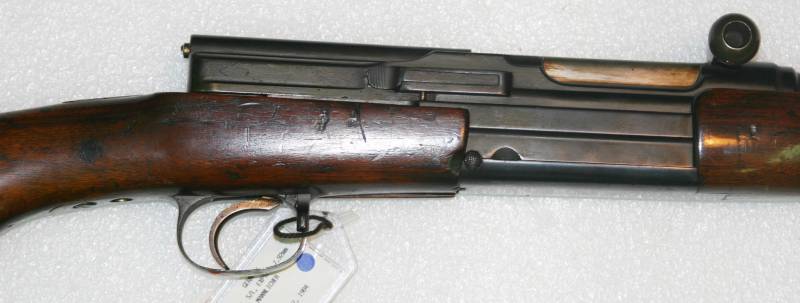
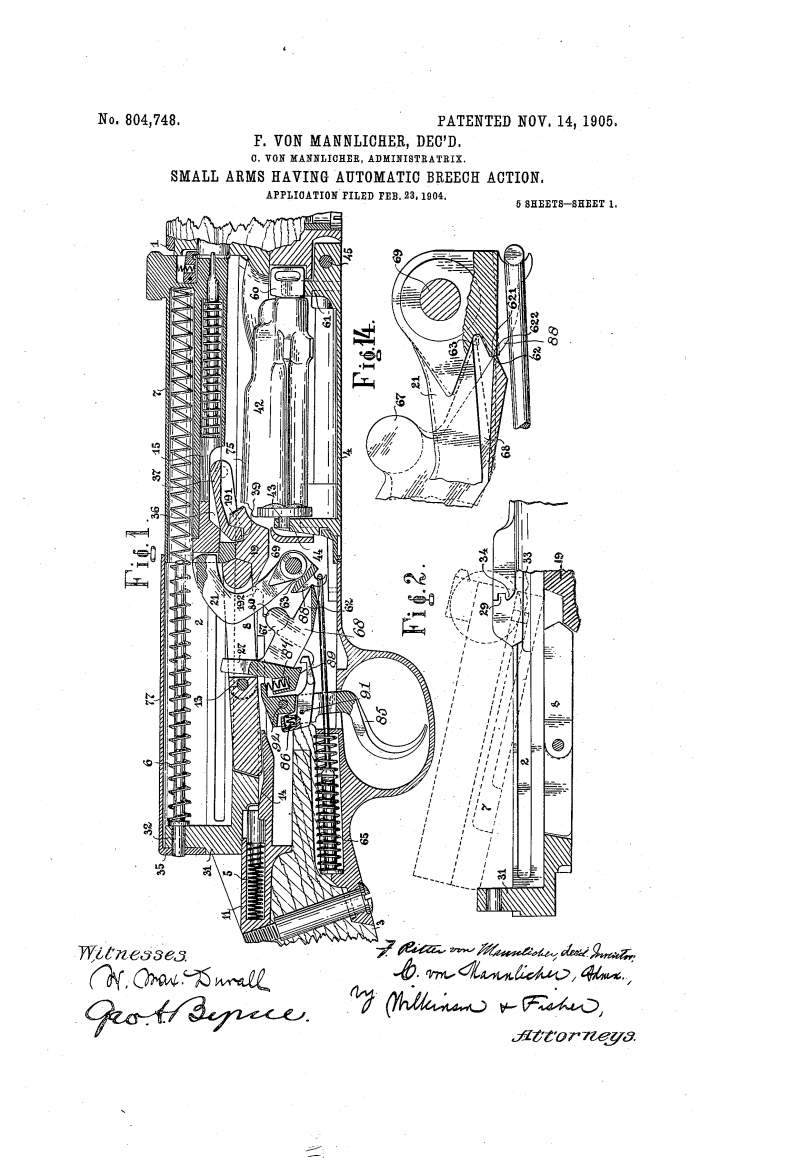
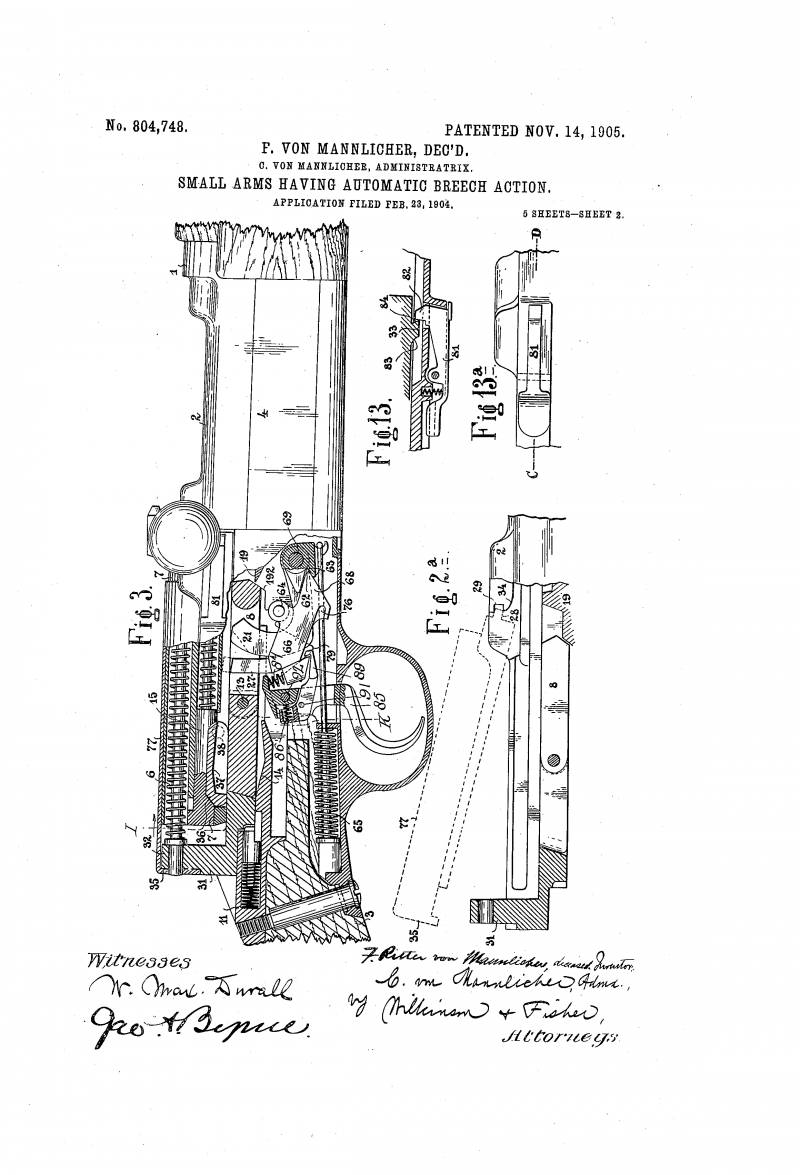
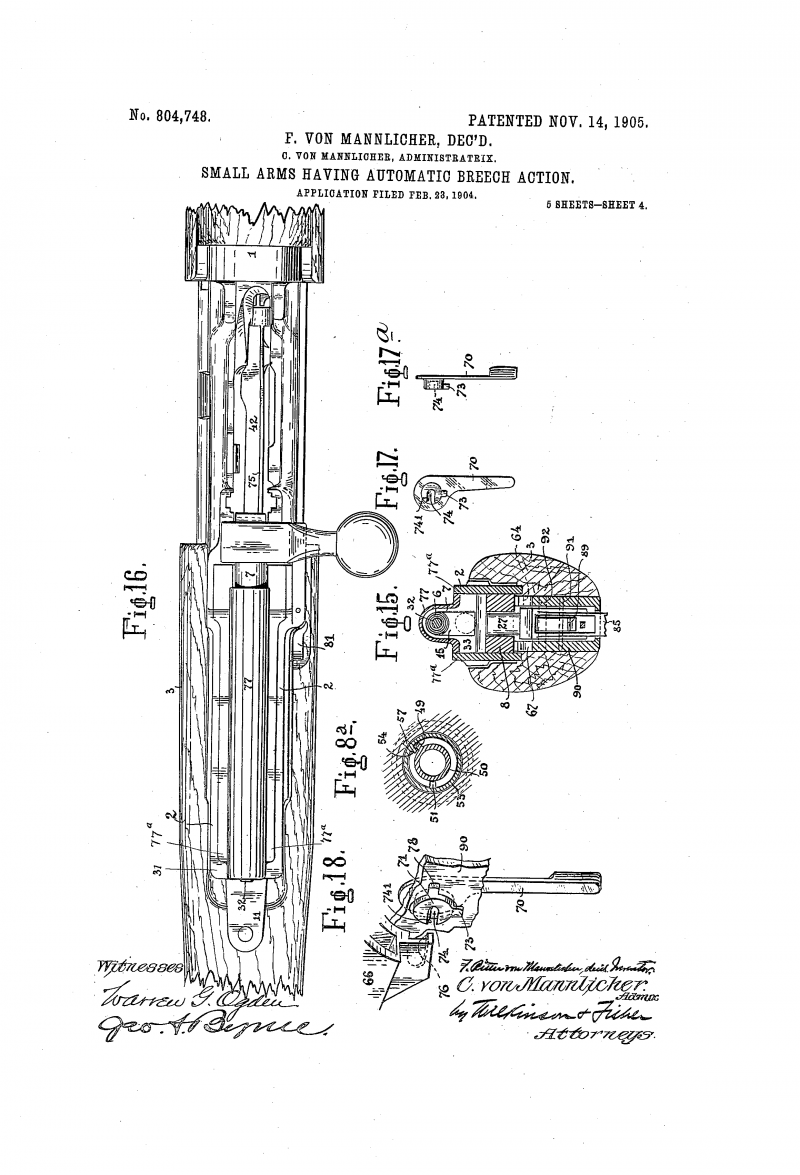
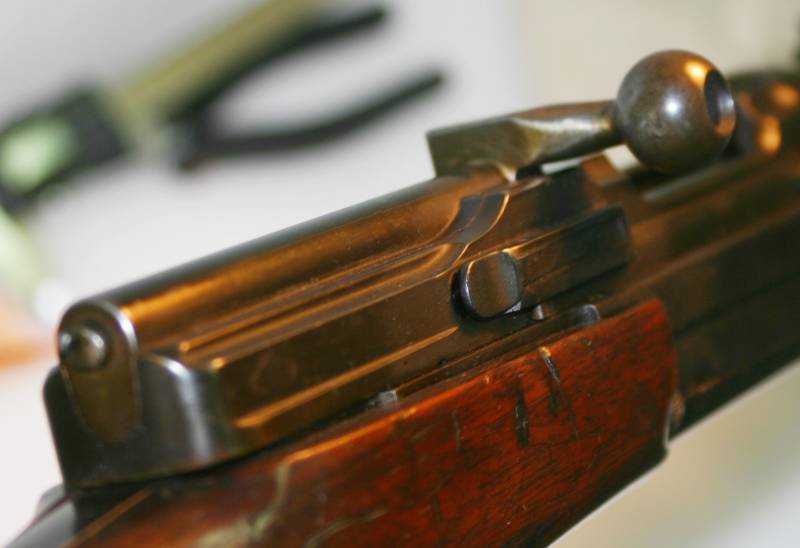
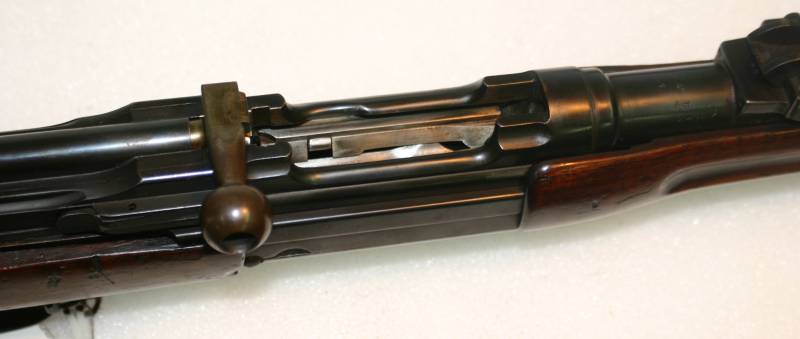
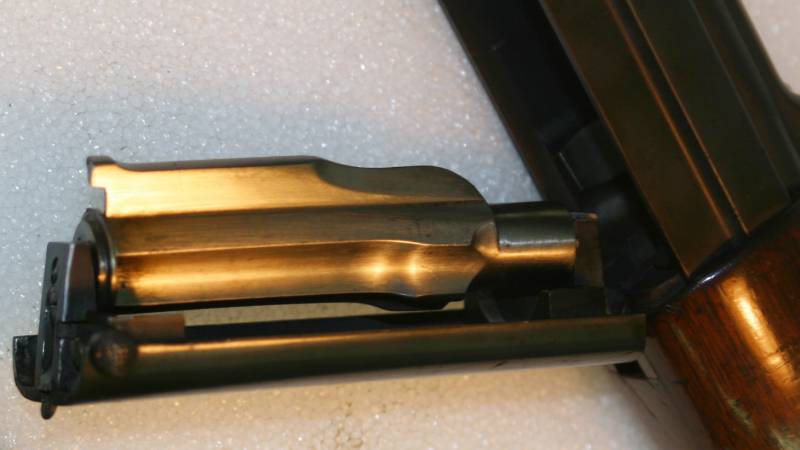

Information